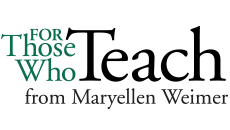Aprevious column on how hard it is to sustain instructional change has got me thinking more about the change process. For years I’ve suggested that our efforts to change need to be more targeted. So often we change by doing some of this, a bit of that, a little something else, and hopping back to what we implemented initially to fuss with it more. It’s not systematic, purposeful, or focused change.
 I’d like to be able to cite some research that supports my claim that targeted change is better, but we really haven’t studied the process of implementing instructional changes very much, or have we studied it at all? Nonetheless, there are many reasons why a targeted approach to improving teaching and learning is the more viable option.
I’d like to be able to cite some research that supports my claim that targeted change is better, but we really haven’t studied the process of implementing instructional changes very much, or have we studied it at all? Nonetheless, there are many reasons why a targeted approach to improving teaching and learning is the more viable option.
- It’s less daunting because you aren’t trying to address every aspect of your teaching. You’re looking at a particular part of it, like your exams, written assignments, the feedback you provide on student work, or your online discussion prompts. You aren’t trying to repair and renew everything, but are focused on one aspect, or maybe a couple of them, if the semester isn’t terribly busy.
- Given that you’re looking at just one area, you can focus on it, look at it thoroughly, examine all its parts, and explore how the parts relate. As a result, your understanding of that aspect of your teaching is more complete.
- With that better understanding, you are more likely to make a good call on what needs to change and how to change it. That could mean getting rid of it, significantly revising and updating it, continuing it but with new features, or replacing it with something new.
- And that better understanding makes for a more substantive review of the alternatives. Now it’s not opting for the next new thing coming down the pike, it’s exploring how a new technique might need to be adapted, given your current approach, your content, and the learning needs of your students. A targeted approach moves you beyond the “just do it” response to the kind of planning that makes success a more likely outcome.
- You can get feedback from students in a way that benefits them and you. Asking students questions that focus on one area helps them to think more clearly about that part of the course. It benefits you because they’re more likely to provide the specific, detailed feedback you need to make adjustments.
- Soliciting feedback on a targeted area makes the evaluation process less judgmental. The impact of an aspect of instruction is best understood by simply having students describe their experiences. How are students doing with the reading in the course? Not how you think they should or how you’re pretty sure they aren’t, but their anonymous responses to queries about when they do the reading, how long they spend on it, what they’re doing while their reading, whether they talk about it with anyone else, and what they do when they don’t understand part of it.
- If you then proceed to implement changes in that area, students are more likely to be involved. They’ve provided feedback, made recommendations, and therefore have at least a modicum of interest in the outcome. Sometimes they actually contribute to the success of those changes.
- Implementation of new activities, assignments, policies, or teaching strategies have the benefit of your full undivided attention. It’s one of those times when doing less ends up accomplishing more.
- Do you have to feel guilty about all those other aspects of teaching that need your attention? No, you’ll get to them. If you’re one of those organized people, you’ll have a master plan that lists all those areas and the date when they’ll be targeted. Decision-making for the rest of us may be a bit more ad hoc but every semester we’ll be working some aspect of our courses.
The targeted approach doesn’t rule out dealing with problems that may emerge in a course or the occasional addition of a new idea that’s too good to ignore, but the overall approach to growth and development as a teacher targets one area of instruction at a time and works through it in a focused way. Is this a better way? What do you think? I welcome your comments.






